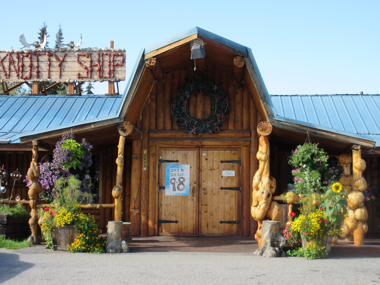
Alaska, Our Last Frontier
As usual for airline travel these days, I was jam packed into each of the four flights it took to get to Alaska. Arriving in Anchorage after 11:30 p.m., which was 3:30 a.m. for me, a cool rain greeted me. The time difference meant I had been traveling for over 20 hours from Gainesville. Brief hours of sleep at the Spenard Hostel, and I was awake and eager to meet up with Walt Rowland from Alaska Bike to put a bike together for me. He had agreed to rent me a bike and give me help with maps, route information, places to stay, and what things to plan for. After loading up panniers I packed up what I would leave at the Hostel until my return after my ride down the Richardson Highway from Fairbanks to Valdez. The next morning, starting early, I loaded the bike, rode to the train station in downtown Anchorage, bought my ticket to Fairbanks, and saw my bike and gear loaded onto the train for the twelve hour ride. The 350 miles between the two largest cities in Alaska, went at what felt like glacial speed because of the slowing for many views of Mt. McKinley, (aka Denali), for a Mother Moose and her young 'uns sprinting away from the train, and for other points of interest along the route. We paralleled the Susitna River for much of the way, which allowed the student guides over the public address system, to give us a tutorial on the kinds of salmon that spawn there, on the mining operations, and many other historic facts relating to our route. Many of the staff explained that this day was the clearest day of the entire summer, with the best views of the tallest mountain in North America.
My host at the first overnight in Fairbanks met me at the train station, loaded my bike into his truck and drove me to my quarters, a small house across from his and his wife's. A former teacher from Utah, he'd come to Alaska to work on the pipeline in the 70's, had made more money than he'd ever seen from teaching, and after his pipeline work ended, stayed with his family in Fairbanks. He said they didn't mind the cold winters until it got below minus 20. That was a different story, he said. It didn't sound like one I particularly wanted to be part of.
I was up early the next morning, loaded my bike, and with directions from my host in hand, I found my way to the beginning of the Richardson Highway. A few miles later, I arrived at the North Pole, a charming little place with a huge Santa Claus and Reindeer prominently displayed. The sign on a bank said 39 degrees at 9:30 a.m. So I found a warm and lovely cafe owned by a Japanese American woman whose husband had worked on the pipeline. Along the route to Salcha, was the Knotty Shop [photo below] where a local farmer was setting up his stand of vegetables. For show, he brought along a 70 pound cabbage and as he explained to me, the long days in summer, the angle of the sun, and the mild climate made possible.

My next stop was the Salchaket Roadhouse, and my room shared the building with the local Post Office for that small town of Salcha, just over 1000 inhabitants. This restaurant appeared to be the center of activity, and after riding many miles without signs of civilization I could see why. The woman in charge informed me that, yes, I could drink the water, despite it's odor and color. Many places in rural Alaska have to truck in their drinking water, (Glennallen, two days farther down the road was one), due to arsenic and other contamination from the unstable underground rumblings and the many earthquakes that happen there. A restaurant at the Roadhouse provided good company for me, as well as dinner, and breakfast before I left the next morning.
I was off toward Delta Junction and my first sightings of the famous Alaska Pipeline that runs some 800 miles from Prudhoe Bay to Valdez. After hearing about the pipeline and reading about it for so many years, seeing It up-close allowed me to appreciate what an amazing feat of engineering it had been to construct, and to acknowledge the scale and scope of the endeavor. When seen from a distance, the diameter of four feet is hard to value as there is nothing man made to compare it to. On closer inspection, it is a gargantuan structure which required engineers to solve all sorts of probems: Building in earthquake zones, crossing streams and creeks underground, [photo below] new bridges for larger crossings, adding hundreds of small service roads in order to monitor the line, for leakage, sabotage, maintenance failures, and gunshot holes, working in extreme cold, working in isolated terrain, and having to develop techniques for building on top of the Permafrost without melting it. Some of the pipeline's vertical supports have heat pipes built into them to prevent the Permafrost from melting and sinking the pipeline. As it crosses the Denali fault, the sliding supports move it when earthquakes hit. It took from 1974 to 1977 to construct, and the first barrel was shipped to Valdez at the end of 1977. By 2010 over 16 billion barrels of crude had reached the Port city for shipment on container ships. (The Exxon Valdez was one such ship which broke open enroute to the lower forty-eight and fouled much of Prince William Sound in 1989 when it hit the Bligh Reef). This past year every Alaskan of any age was paid a per capita amount in excess of $1900 due to the revenue from the pipeline.
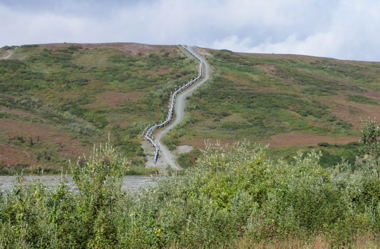
Early in the day, I began feeling poorly enroute to my next stop, and on one big climb stopped several times to get catch my breath. I wondered whether I would be able to make it to the top, let alone the remainder of the fifty-seven miles I needed to travel that day. That prompted me to locate the Delta Junction Family Medical Center, the next day, and I rode there in a heavy downpour. The only doctor within a hundred mile radious informed me that I had contracted bronchitis. It was a relief to receive good medical help from a competent professional. Now at least, I could be hopeful about being able to continue my trek southward, and optimistic about finishing what I'd started.
It made sense for me to lay over in Delta Junction for an extra day to recuperate, as I was looking at a 75 mile ride to my next stop down the road. By the following day, it still looked unlikely that I could make that mileage, as much of it was an uphill enroute to Isabel Pass. Hitching a ride with whomever would take me and my bike seemed to be the sensible way to lessening the distance. I packed my panniers early and went next door to the gas station and began asking whomever stopped there if they were heading south. Several tries later, Peter from Minnesota and Jeremy from Soldatna, said they'd be happy to oblige, put my bike in the back of their pick-up and me in the back seat with their guns. We made a quick stop at the Hardware store where we saw a recently killed moose on the back of a four-wheeler behind an RV. [photo below] Jeremy gave me a lesson in the size and calibre of moose that they were looking for in their own hunting quest. This recently killed moose had more than the required distance between the two branches of antlers, and more than the required “brow tines”, which made this a primo catch for the lucky hunter who bagged it. These guys were most gracious and went out of their way to give me a lift part way to the pass, and Water's Edge RV Park for my next overnight place.

Rainbow Ridge [photo below] was one of the most colorful and beautiful places that I saw along the route, despite the dusting of the previous night's snow covering some of the colors at the top of the ridge. I was concerned about camping in my convalescent condition, so I requested a cabin which came with warm water and lots of heat. I spent time talking to the owner Lee Harper, a Vietnam Veteran who gave me a break on the price based on my own connection to that era. From some of his friends who visited that night I learned lots about the ways of hungry bears coming out of hibernation in the spring, and breaking into any house whose occupants had been careless in not boarding up doors and windows against their ferocity. First the bears would, break whatever they needed to get inside, be it door or window, then they would eat whatever dry goods were left there, proceed to trash the place ripping cabinets from the walls, overturning furniture, and as a parting shot, they would defecate over much of the interior. This surely would give new meaning to Winnie the “Poo”!
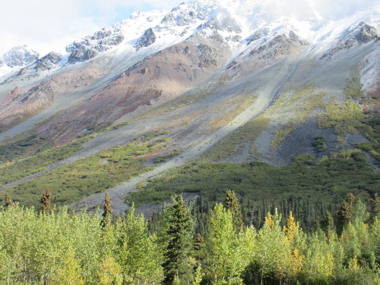
Being out in the middle of nowhere off-grid, power can be an expensive proposition for these hardy Alaskans. That very day, Lee the owner had installed a solar array to defray the cost of using propane for power. As I prepared to leave the next morning, I was particularly happy that I'd been inside all night noting the temperature at 26 degrees Fahrenheit. The twenty miles to Meier's Lake Roadhouse were extremely cold. Feet, hands, face—I don't remember being so cold on a bike ride. Lee had called ahead to alert the Roadhouse owner, Wiley, to my imminent arrival and he remarked at what good time I had made from Isabel Pass. I was highly motivated to get out of the cold and the downhill coming off of the pass helped to speed me along my way.
After warming with cups of hot tea and breakfast helping to thaw me out, I reluctantly left the warmth of the Roadhouse. Another 57 miles stretched ahead before my next stop at Glennallen.
As I had discovered earlier, there were no services along the way, and answering nature's call was a big gamble in terms of the exposure it presented. The road bed was built up on great gravel base over Permafrost of about 8 to 10 feet above the tundra. [photo below] A scramble down the incline would put me directly into the swamp itself, and trees were non-existent close enough to the road to offer cover. The next passing car, truck or RV were few and far between, yet there was no real way of predicting their arrival. Still, when nature calls, especially when one is out in nature without any alternative, one must answer!
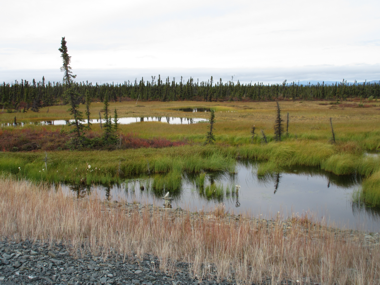
Into Glennallen around 4:30 p.m., found the next Northern Nights Campground, and because the rain began in earnest just after my arrival there, I rented a small cabin. The rain stayed strong all night, and the next morning and I made a decision to stay an extra day because the weather was supposed to clear the following day. The manager of the Park drove me to the grocery store so that I could stock up on food, and the cabin had a microwave, and was well heated.
I left early the following day, which brightened with a mist, expanded to a drizzle, and became a full blown rain all of the 60 miles to the Tiekel River Lodge. Most of the great scenery I would have seen was being obscured by low lying clouds along the route through Copper country. At about halfway, I stopped at BJ's Gifts for hot tea, and an interesting conversation with B.J. who had escaped an abusive husband in Oregon thirty or so years before, fled to Alaska with two kids and made a life for herself. By the time I got to the Lodge, everything I wore was sopping wet, and as soon as I stopped riding, I was pretty cold. Kim and Phil were kind and welcoming, fed me lunch and dinner at the Lodge, and after I rinsed out some of my wet clothes, Kim dried everything for me in the dryer. This was especially generous of her as the lodge was totally off the power grid and making their own power was at a great expense.
The next day cleared nicely while I climbed the 6.5 miles to the summit of Thompson Pass, and the sun shone brightly as I rode by Worthington Glacier, with the wind practically blowing me off the road. [photo below] The views were marvelous. There was a tremedous 8 mile downhill through the Keystone Canyon as the road followed a river carving the route out of solid rock into Valdez. The speed of the downhill and the wind added up to a very wild ride for me.
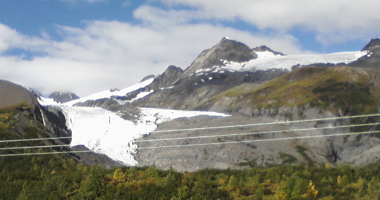
Arriving into Valdez, I located the Eagle's Rest Park where I paid for camping, pitched my tent and rode to the Ferry Terminal to purchase a ticket across Prince William Sound for early the next morning. A six hour trip across the Sound was smooth sailing, with sightings of whales, birds, and glacial ice along the way. I talked to most of the passengers on the ferry as I was searching for someone to take me and my bike through the Whittier tunnel at the end of the trip across. Pedestrians or cyclist are not allowed in the mile and a half tunnel for safety reasons. Andrew, a 20 something student offered to take me an my bike all the way back to Anchorage, provided I didn't mind sharing the back seat with his large red dog named MacTavish who had to be left alone during the crossing. Andrew had expressed concern for him, yet he seemed to have weathered the separation well. I was driven directly to the Hostel in Anchorage and once there, I retrieved the other parts of my luggage, did laundry, reorganize my gear, and socialized with other people staying at the hostel.
I saw NO bears, although I got some bear stories, bear safety advice for camping, saw bear safety signs in campgrounds, and I carried a large can of bear spray just in case. Actually, I did see a stuffed Grizzly at the Anchorage Museum after my return. Later I learned that at this time of year bears had better things to fill their bellies with since berries were plentiful along the route and salmon were swimming upstream in great numbers. Two of my roommates at the Spenard Hostel each paid $350 to take a “Flight”-Seeing tour by helicopter in order to feast eyes on an actual live grizzly. They were from Australia, so that could explain their interest, although seeing Alaska by plane is what many tourists chose to do. I prefer the two wheeled approach.
However, that didn't stop my own bear anxiety overtaking me at one point while riding the Richardson Highway, on a day when I saw nothing of civilization, (no houses, stores, gas stations, no people), save the odd car, truck or RV rolling by. My mind began a wild run, and I conjured a 600 pound Grizzly jumping out of the woods in front of my bike. After regaining my sanity however, I continued pedalling southward toward Valdez, in concert with the great Alaska Pipeline, which had become my sole companion of sorts, and I was able to enjoy yet another view of lakes, rivers, snow capped mountain ranges, glaciers, tundra, trees, wildflowers, and the wide open spaces that define the Alaskan experience.